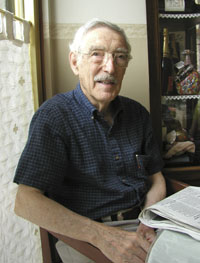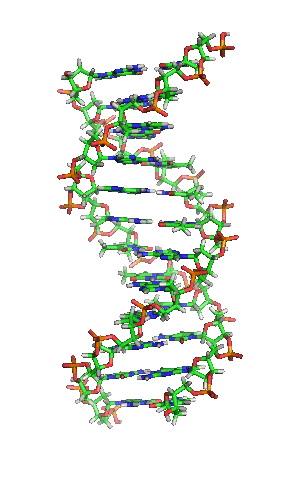
A carcinogen is any substance, radionuclide, or radiation that promotes carcinogenesis. This may be due to the ability to damage the genome or to the disruption of cellular metabolic processes. Several radioactive substances are considered carcinogens, but their carcinogenic activity is attributed to the radiation, for example gamma rays and alpha particles, which they emit. Common examples of non-radioactive carcinogens are inhaled asbestos, certain dioxins, and tobacco smoke. Although the public generally associates carcinogenicity with synthetic chemicals, it is equally likely to arise from both natural and synthetic substances. Carcinogens are not necessarily immediately toxic; thus, their effect can be insidious.
Mutagenesis is a process by which the genetic information of an organism is changed by the production of a mutation. It may occur spontaneously in nature, or as a result of exposure to mutagens. It can also be achieved experimentally using laboratory procedures. A mutagen is a mutation-causing agent, be it chemical or physical, which results in an increased rate of mutations in an organism's genetic code. In nature mutagenesis can lead to cancer and various heritable diseases, and it is also a driving force of evolution. Mutagenesis as a science was developed based on work done by Hermann Muller, Charlotte Auerbach and J. M. Robson in the first half of the 20th century.

In genetics, a mutagen is a physical or chemical agent that permanently changes genetic material, usually DNA, in an organism and thus increases the frequency of mutations above the natural background level. As many mutations can cause cancer in animals, such mutagens can therefore be carcinogens, although not all necessarily are. All mutagens have characteristic mutational signatures with some chemicals becoming mutagenic through cellular processes.
Genotoxicity is the property of chemical agents that damage the genetic information within a cell causing mutations, which may lead to cancer. While genotoxicity is often confused with mutagenicity, all mutagens are genotoxic, but some genotoxic substances are not mutagenic. The alteration can have direct or indirect effects on the DNA: the induction of mutations, mistimed event activation, and direct DNA damage leading to mutations. The permanent, heritable changes can affect either somatic cells of the organism or germ cells to be passed on to future generations. Cells prevent expression of the genotoxic mutation by either DNA repair or apoptosis; however, the damage may not always be fixed leading to mutagenesis.

Bruce Nathan Ames is a prominent American biochemist. He is a professor of Biochemistry and Molecular Biology Emeritus at the University of California, Berkeley, and was a senior scientist at Children's Hospital Oakland Research Institute (CHORI). Throughout his career, Dr. Ames has made significant contributions to understanding the mechanisms of mutagenesis and DNA repair. One of his most notable achievements is the invention of the Ames test, a widely used assay for easily and cheaply evaluating the mutagenicity of compounds. The test revolutionized the field of toxicology and has played a crucial role in identifying numerous environmental and industrial carcinogens.

A molecular lesion or point lesion is damage to the structure of a biological molecule such as DNA, RNA, or protein. This damage may result in the reduction or absence of normal function, and in rare cases the gain of a new function. Lesions in DNA may consist of breaks or other changes in chemical structure of the helix, ultimately preventing transcription. Meanwhile, lesions in proteins consist of both broken bonds and improper folding of the amino acid chain. While many nucleic acid lesions are general across DNA and RNA, some are specific to one, such as thymine dimers being found exclusively in DNA. Several cellular repair mechanisms exist, ranging from global to specific, in order to prevent lasting damage resulting from lesions.

Jacqueline K. Barton, is an American chemist. She worked as a professor of chemistry at Hunter College (1980–82), and at Columbia University (1983–89) before joining the California Institute of Technology. In 1997 she became the Arthur and Marian Hanisch Memorial Professor of Chemistry and from 2009 to 2019, the Norman Davidson Leadership Chair of the Division of Chemistry and Chemical Engineering at Caltech. She currently is the John G. Kirkwood and Arthur A. Noyes Professor of Chemistry, Emerita.
Philip C. Hanawalt is an American biologist who discovered the process of repair replication of damaged DNA in 1963. He is also considered the co-discoverer of the ubiquitous process of DNA excision repair along with his mentor, Richard Setlow, and Paul Howard-Flanders. He holds the Dr. Morris Herzstein Professorship in the Department of Biology at Stanford University, with a joint appointment in the Dermatology Department in Stanford University School of Medicine.

In molecular genetics, a DNA adduct is a segment of DNA bound to a cancer-causing chemical. This process could lead to the development of cancerous cells, or carcinogenesis. DNA adducts in scientific experiments are used as biomarkers of exposure. They are especially useful in quantifying an organism's exposure to a carcinogen. The presence of such an adduct indicates prior exposure to a potential carcinogen, but it does not necessarily indicate the presence of cancer in the subject animal.
At its simplest, the adductome is the totality of chemical adducts that are present in particular cellular macromolecules such as DNA, and RNA, or proteins found within the organism. These adducts can detrimentally alter the chemical properties of these macromolecules and are therefore also referred to as damage. Adducts may arise as a consequence of the chemical reaction between a given "physicochemical agent to which an organism is exposed across the lifespan". These physicochemical agents can be exogenous in origin, and include ionizing and non-ionizing radiation, the diet, lifestyle factors, pollution, and xenobiotics. They made damage the macromolecules directly, or indirectly e.g., some xenobiotic substances require metabolism of the xenobiotic to produce a chemically reactive metabolite which can then form a covalent bond with the endogenous macromolecule. Agents that damage macromolecules can also arise from endogenous sources, such as reactive oxygen species that are a side product of normal respiration, leading to the formation of oxidatively damaged DNA etc., or other reactive species e.g., reactive nitrogen, sulphur, carbon, selenium and halogen species.
Lorena Beese is a James B. Duke Professor of Biochemistry and Duke Cancer Institute Member. Her research involves structural mechanisms underlying DNA replication and repair, neurodegenerative diseases, cancer, and microbial pathogenesis; X-ray crystallography and cryo-electron microscopy; structure-based drug design; protein-protein and protein-nucleic acid interactions, enzyme mechanisms, chemical biology, protein structure and function.

Leona D. Samson is the Uncas and Helen Whitaker Professor and American Cancer Society Research Professor of Biological Engineering at the Massachusetts Institute of Technology, where she served as the Director of the Center for Environmental Health Sciences from 2001 to 2012. Before her professorship at MIT, she held a professorship at the Harvard School of Public Health. She is on the editorial board of the journal DNA Repair. Her research interests focus on "methods for measuring DNA repair capacity (DRC) in human cells", research the National Institute of Health recognized as pioneering in her field, for which the NIH granted her the National Institutes of Health Director's Pioneer Award.
Bernd Kaina, born on 7 January 1950 in Drewitz, is a German biologist and toxicologist. His research is devoted to DNA damage and repair, DNA damage response, genotoxic signaling and cell death induced by carcinogenic DNA damaging insults.

Steven R. Tannenbaum was born and grew up in the Rockaways of Queens, New York City. He attended the Hebrew Institute of Long Island through 9th grade, then moved to Hewlett, Long Island where he graduated from Woodmere H.S. in 1954. He attended the Massachusetts Institute of Technology from 1954-1962, earning a B.S. in Food Technology in 1958 and a PhD. in Food Science in 1962. He was then appointed to Assistant Professor in 1964 in the Department of Food Science and Technology leading up to Full Professor in 1974. Throughout his career he was mentored by Samuel A. Goldblith up until his death in 2001. In 1973 Tannenbaum did a sabbatical at the Hebrew University of Jerusalem, where he decided to switch his career into cancer research at the suggestion of Gerald Wogan.
Nancy L. Craig is a professor emerita of molecular biology and genetics at the Johns Hopkins University School of Medicine. She has done pioneering research on the molecular mechanisms of transposable elements, or mobile sequences of DNA found in the genomes of most known organisms.
Birgit Vennesland was a Norwegian-American biochemist. Vennesland spent the majority of her career as an academic for the University of Chicago from 1941 to 1968. While at Chicago, she compared the enzymes that animals use during metabolism and to the enzymes used by plants in photosynthesis. After leaving Chicago for Germany, Vennesland was the director of the Max Planck Institute for Cell Biology from 1968 to 1970. She later was the director of an eponymous research facility by the Max Planck Society from 1970 until her retirement in 1981. During her career, Vennesland received the Stephen Hales Prize from the American Society of Plant Biologists in 1950 and the Garvan-Olin Medal from the American Chemical Society in 1964.

Robyn Leigh Tanguay is an American researcher, academic and educator. She is a distinguished professor in the department of environmental and molecular toxicology at Oregon State University. She is the director of Superfund Research Program, the director of Pacific Northwest Center for Translational Environmental Health Research and the director of Sinnhuber Aquatic Research Laboratory at OSU.

Chryssostomos Chatgilialoglu, is a Greek-Italian chemist and his work has mainly focused on free radical reactions. His parents Christos and Penelope were ethnic Greeks from Asia Minor and he was born in 1952 in Nikaia Greece where he grew up and went to school until the age of 18. He is currently President of the company Lipinutragen and associated with the National Research Council (CNR) of Italy in Bologna and Adam Mickiewicz University, Poznań (Poland).
Diana Anderson is a British biomedical scientist who is a professor at the University of Bradford. Her research has focussed on early cancer detection and genome stability. She was appointed an Order of the British Empire in 2022 for her services to cancer detection.
Sheila Sue David is an American chemist who is a professor at the University of California, Davis. Her research uses chemical approaches to understand cellular mechanisms, including DNA repair. She focuses on the repair of damaged DNA bases, which is mediated by base excision repair. She is a Fellow of the American Chemical Society and American Association for the Advancement of Science.









